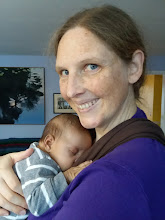Hard to believe the course will finish in two weeks. A few notes on the last places we have visited, then. Photos will have to wait, since they are on my home computer and I am once again in the field.
At the beginning of April we visited San Gerardo Biological Station at the edge of the Children’s Eternal Rainforest in Monteverde. The reserve, a complex of cloud-laden mountaintops along the contintental divide, came about through one of those heartwarming 1980s “children save the world” efforts, in which kids from all over the globe contributed to purchase protected land. Twenty-some years later, it is gratifying to see the land still protected and the forest growing back. The managers of the field station were a family who had lived there when the area was still farmed, and they pointed out where their pastures had been. You can still see the difference clearly between the new forest—spindly Heliocarpus trees with an understory of shrubs and a few grasses—and the gnarled, moss-covered, hulking trees of the old forest. Almost all the pastures have grown in, though, and the birds are beginning to come back into the young forests. We saw a blue and gold tanager (which, if you know birds, is apparently a big deal) hopping around in the edge of the old pasture area. I went looking for umbrella birds and bellbirds, a pair of unusual and attractive species endemic to this mountain range, but I didn’t spot any. One of my students saw four umbrella birds while he was out looking for plants. Figures!
One of the best things about San Gerardo was the unobstructed view of Arenal, an active volcano that is a major tourist attraction for this part of the country. The lava flows on Arenal aren’t smooth rivers, but rather tumbling aggregations of half-molten bolders. I think the technical term is a pyroclastic flow. Visually, it looks like the mountain is full of trapped light that occasionally struggles to the surface. The view from San Gerardo was better than anything I saw in La Fortuna (the tourist trap village at the base of the volcano); at night when it was clear we could see the glint of orange lava where the mountainside broke open. Even in the day we could occasionally see puffs of smoke in lines where flaming boulders went bouncing away down the slope.
I was surprised how many clear nights we had at San Gerardo. From my limited experience of cloud forests, I had expected unrelenting gloom. This is the tail end of the dry season, though, and we only got rained on twice. The second time was on the hike out—4 km uphill with all our gear in backpacks. I was actually glad it was raining; it kept the temperature down and made the steep uphills more bearable. I was reminded of a day on the Appalachian Trail years ago, when I was hiking through the rain with the inimitable Waterfall. I’ve never liked rain very much, especially cold rain, but Waterfall had a way of seeing the best in every situation.
“Don’t the plants look happier being wet?” she said. I had to agree.
The plants at Monteverde certainly seemed happier in the rain, and the landscape, too, seemed to take on its true dimensions with wisps of fog and rain obscuring the distant mountains. It was impossible to see how far the mountains extended, impossible to see the pastures and cleared areas in the lowlands. Aside from the road—a one-lane mud track suitable only for quad bikes and intrepid horseback riders—it seemed that we were in the wilderness primeval.
Leaving Monteverde, we headed for Cabo Blanco on the tip of the Nicoya Peninsula. Cabo is closer to wilderness primeval, actually, although the scrubby, dry, vine-festooned secondary forest there is not nearly as interesting. Cabo Blanco is an absolute reserve: only researchers and a select few students ever get to see the place. When no academic groups are visiting—much of the year—the station is boarded up and left for the land crabs, racoons, and monkeys. Cabo was Costa Rica’s first national park, in 1963. At the time it was converted to park, the area was all cornfields and pastures, so the forest is not much to look at. But the park was really established to protect the shoreline and the marine areas. At low tide, rock formations make a natural lagoon that is home to shells, corals, anemones, fanworms, and shoals of colorful fish. Very few people ever get to see an undisturbed reef like this one. We even spotted a sea turtle, a small leatherback, making its ponderous way along the sea floor in the lagoon. My favorite animal was a tiny blenny, about as big around as a pencil, with a green body and rings of bright red like makeup around its eyes and mouth. Their googly eyes and oversize bright red lips give them something of a Betty Boop look.
The one drawback of being at the beach, for me, is that my skin just doesn’t tan. Aside from a few freckles, I go from white to burned faster than toasted Wonder Bread. I’ve always been more of a forest person than a beach person, partly for this reason. I was very careful to keep myself slathered with sunscreen and covered up as much as possible, even to the point of wearing long sleeves and long pants while I was snorkeling. (I’m sure it wasn’t the most attractive beach outfit—sopping wet button-down shirt and field pants—but besides the anti-burn protection it also kept me insulated in the relatively cool Pacific waters.) Despite my precautions, I ended up with a perma-freckled face.
After a short few days at home, I’ve re-joined the course at La Selva for the final stretch. I don’t feel quite as rested as I would like to be, but it’s just two weeks…


0 Comments:
Post a Comment
<< Home